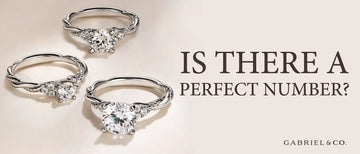
Before the “Will you marry me?” comes the quiet panic: “How many carats should the engagement ring be?” It’s the question that sends many into a spiral of googling, guessing, and second-guessing. But before jumping to numbers, it’s worth slowing down to understand what carat weight really means. Choosing the perfect diamond is a conversation between style, budget, and how you imagine this ring will capture her heart for years to come. This guide isn’t meant to chase trends or rules. It’s here to help you decode how a diamond’s carat size shows up in real life and how to make it work for you.
Engagement Ring Carat Guide: The Numbers
There’s no universal magic number. Anyone who claims “X carats is ideal” is glossing over the nuances that actually matter. Carat weight isn’t one-size-fits-all—it’s personal. What looks bold on one hand might feel minimal on another. What feels right for one lifestyle might be wildly impractical for another.
That said, numbers can serve as helpful starting points. Let’s take a look at them, and then talk about why they may not matter as much as you’d think.
Average Carat Size for Engagement Rings in the US, UK, and Globally
- United States: Approximately 1.00 to 1.20ct. Larger stones are more common here, thanks in part to cultural preferences and marketing trends.
- United Kingdom: Typically around 0.60 to 0.80ct. Taste tends to favor understated, minimalist styles.
- Globally: It varies significantly. In countries like Japan and China, average sizes tend to be smaller—closer to 0.30 to 0.50ct. Meanwhile, Australia and Canada usually fall somewhere in the middle.
These numbers are useful for comparison, not instruction. After all, you’re not buying a diamond to meet a global average. You’re buying it to fit your life.
What Does Carat Size Look Like on a Hand?
This is where numbers meet reality. A carat’s true presence is revealed not in isolation, but when it rests on your hand. Let’s explore the optimal carat weights for different hand sizes.
Small Fingers (US size 4–5)
Smaller fingers offer more visual payoff per carat. A 0.70ct stone can easily give the impression of a full carat. However, if it is too large, the ring may begin to feel disproportionate or overwhelming.
Medium Fingers (US size 5.5–6.5)
This range offers great flexibility. A 1.00ct diamond typically strikes a lovely balance; noticeable yet refined. Craving more impact? Small tweaks in shape or setting can amplify the look without adding carat weight.
Larger Fingers (US size 7 and up)
With more space on the hand, diamonds can appear smaller. However, that doesn’t necessarily mean you need to increase the carat weight. Elongated shapes or thoughtfully designed settings can help a modest stone feel right at home.

Visual Impact of Diamond Shape
Not all carats wear the same. A 1.00ct round and a 1.00ct oval may weigh the same, but they won’t appear identical. Certain shapes distribute their weight more efficiently across the finger, while others tuck more depth into the cut. Let’s break this down:

Oval
Elongated and graceful, ovals typically cover more surface area than rounds of the same weight. An oval-cut engagement ring is a clever choice if you're looking for a larger visual presence without additional weight.
Marquise
Long and tapered at both ends, a marquise-cut engagement ring draws the eye across the hand. Its narrow silhouette offers generous coverage per carat, making it appear larger than it actually is.
Emerald
With its clean lines and mirror-like facets, the emerald cut is all about structure and clarity. While it tends to carry more weight beneath the surface, its broad, open table and elongated shape can make it appear larger face-up than many other cuts. An emerald-cut ring is less about sparkle and more about bold, architectural beauty.
Cushion
With soft corners and a deeper cut profile, a cushion-cut engagement ring is undeniably romantic. However, that added depth can result in a slightly smaller face-up appearance compared to other shapes of the same weight.
Round Brilliant
The quintessential classic. It’s bright, symmetrical, and versatile, but not the most efficient when it comes to visible size. When you choose a round-cut engagement ring, you're investing in brilliance and sparkle rather than spread.
Pear
With its teardrop silhouette, the pear shape adds a touch of drama and elongates the finger. A pear-cut diamond ring tends to appear larger thanks to its extended profile. You can wear it point-up or point-down, depending on which direction you’d like to emphasize or elongate.
Princess
A square cut with strong corners and brilliant faceting, it tends to look slightly smaller face-up than round or oval cuts. Nonetheless, a princess-cut diamond ring emanates a striking sparkle and a modern edge.
Radiant
A hybrid of emerald’s silhouette and brilliant-style faceting, a radiant-cut engagement ring delivers a strong visual impact. Its rectangular shape can appear larger face-up, especially when set with minimal metal around the edges.
Setting Style and Its Effect on Size Appearance
Engagement ring settings can completely change how a diamond looks on your hand. More than a frame, it shapes how the stone is perceived. Let’s break down the settings that make a difference.

Halo
A ring of smaller diamonds encircling the center stone creates the illusion of a larger gem and enhances the overall sparkle. A halo setting can visually add half a carat (or more), without increasing the center stone’s weight or price.
Bezel
This sleek, modern style encases the diamond in a thin metal rim. While a bezel setting offers excellent protection, it can slightly reduce the stone’s visible surface area.
Cathedral or Elevated Settings
Raising the diamond above the band gives it added height and presence. A cathedral setting lift draws the eye and helps the stone feel more prominent, regardless of carat weight.
Thin Bands (Skinny Shanks)
A slimmer band provides contrast, making the center stone appear larger. It's an elegant way to amplify the diamond’s look through clever proportion.
Carat Weight and Diamond Quality
Carat weight never stands alone. As the size of the diamond increases, so does the importance of the other three Cs: cut, color, and clarity. Larger diamonds reveal more of their internal characteristics. That said, slight tints in color or small inclusions are easier to spot than they would be in a smaller stone. And if the cut isn’t right? Even a big diamond can look lifeless. Meanwhile, a smaller stone with top-tier cut and clarity can light up a room. That's why it’s not about chasing the highest carat weight, but rather finding the sweet spot between what looks good, performs well, and fits your priorities.
Budgeting for Carat Size
Carat weight is one of the biggest factors in a diamond’s cost. Even a small jump—from 0.90ct to 1.00ct—can lead to a significant price increase, despite a nearly imperceptible difference in size. And the higher you climb, the more you'll pay per carat. That’s the premium of scale.
Tips for Maximizing Value
If you’re meticulous about value, which is the right direction to go, here’s what to look out for when choosing your forever ring:
1- Prioritize Cut Quality
A well-cut diamond, even at a smaller carat, will always outperform a larger but poorly cut one. A top-tier cut maximizes brilliance, so prioritize cut over size when possible.
2- Be Strategic About Color and Clarity
Diamonds in the near-colorless range (like G or H) often appear just as bright as higher-grade stones but with a friendlier price tag. As for clarity, small inclusions are often invisible to the naked eye, especially in smaller stones or brilliant cuts.
3- Use Setting to Your Advantage
A well-chosen setting can elevate the look of your diamond. Think halo accents or slender bands to enhance visual size without the added cost of extra carat weight.
Choosing the Right Engagement Ring Carat Size for Her
Knowing what matters to you is just the beginning. The next step? Translating those insights into a ring that’s made to match, starting with questions and ending with customization.
Questions to Ask Yourself
To understand what you really want in a ring, start by asking yourself a few questions. Your answers will definitely help your decision-making process. Here’s a start:
What’s most important to me?
Is it size, sparkle, or a flawless appearance? Clarifying your priorities helps guide the right balance between carat weight and overall quality.
How does the diamond look on my hand?
Consider your finger size and the effect of different shapes and settings. What works visually may differ based on your hand, so try on different sizes to get a feel for what suits you best.
What’s my budget?
Set a realistic budget and explore the best balance between size and quality within that range. Bigger isn't better if it means compromising brilliance or going overboard.
Written By: Gabriel Editorial Team






























